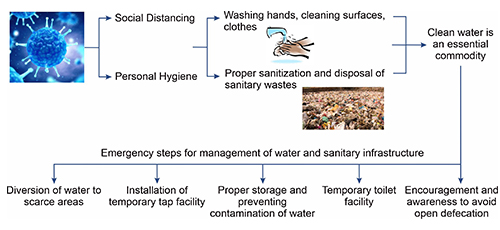"Demonstration of intrinsic properties of the materials and polymer science for health and energy” A unique blend presented in the 11th Issue, Volume 11 of Advanced Materials Letters, November 2020
This year marks one milestone in the beautiful scientific journey that is the concept of polymerization. In 1920, an organic chemist Hermann Staudinger published an article on “Polymerizations”, in front of world scientific community, which later revolutionized life of world. International Association of Advanced Materials (IAAM) is celebrating and supporting field of macromolecular science and “100th anniversary” this year by initiating a range of article promotion throughout the year. Nevertheless, materials science faces great challenges and opportunity together due to pandemic crisis and advancement of technology, respectively.
International Association of Advanced Materials (IAAM) generates opportunity to sustainability movement in materials science and technology by publishing research articles in its official journal, Advanced Materials Letters (AML) free of cost. AML has focused here on the theme “Advancement of Materials to Global Excellence”. IAAM propagating relevant information and promoting sustainable activity with special focus on Health, Energy, and Environment with expert members of worldwide materials community.
The significance of 11th issue of the AML lies in 09 informative articles covering intrinsic properties of the materials science and polymer science in terms of health and energy for global sustainability. The first article on current pandemic discussed about sanitation management for COVID-19, a deadliest virus disease. This article highlighted the importance of wastewater management and need of sanitization through policy and materials technology. Another most important article on pathogen control discussed about green synthesized AgNPs, which are ecofriendly, mono-dispersed, naturally renewable and cost effective against pathogen control.
Another highlights of the issue in Polymer science, covered several articles such as, second article present an understanding of polymeric energy materials, where review presents the state of research in the development of conducting polymers (CPs) polyacetylene (PA). Furthermore, C. Rosales and co‐workers in the third article, have shown about the process by which recycled waste is transformed into materials with improved performance, adding value and widening their application field. Here different copolymer based compatibilizers discussed for improved characterization. The design and modelling of carbon fiber grid structure for enhanced microwave absorbing properties is important aspect discussed in eight article by mentioning wide applications ranging from medical, mobile, travel industry etc. The ninth article focused on strength of bioceramic by integrating other materials and using polymeric sponge replication method. Another article covered use of bio ceramics made from mangrove bark. Both above articles thus enrich materials world information through describing ecofriendly materials, which enhance the biocompatibility and bio-functionality, and work as substitute of harmful chemicals.
The fifth and sixth articles clarified the complex materials characteristics through deep research of superconducting and photoinduced electron transfer reactions, respectively. Above two articles have valuable information, which can contribute to establishing materials functionality more usable with enhanced properties.
All the articles published in the 11th issue contain substantial information’s of materials research and polymer science for making once again AML a renowned source of relevant advanced materials content. IAAM mostly engaged in developing sustainable environment through promoting research, technology, and innovation via its not-for-profit, Diamond Open Access (DOA) advanced materials journals under flagship of ‘Advancement of materials to sustainable and green world’.
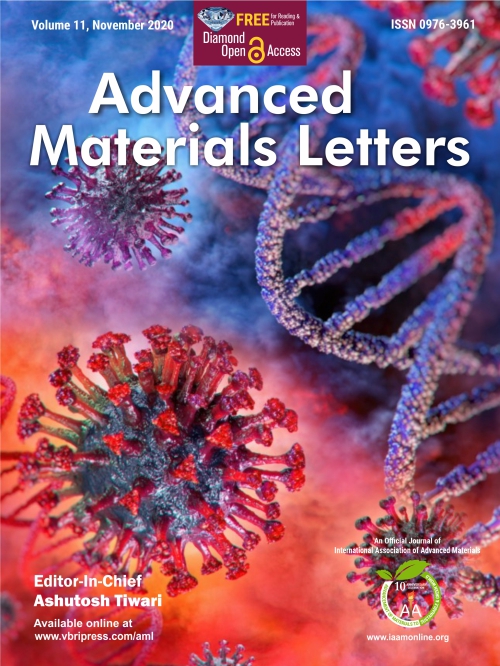 About Cover
About Cover
Public health authorities envision a world without pandemics and standard healthcare practices for diagnosis and control. Worldwide there are currently more than ~40 million persons affected due to the pandemic. As more countries report infection and lock-down, public health authorities are coming up with unique solutions. Currently, the World Health Organisation and Government authorities are engaged in spending up to billions of dollars to improve disease surveillance, sanitation practices, and control. Although improvement is slow as implementation will require more dedicated efforts until the vaccine arrives. The cover photo of the November 2020 issue of Advanced Materials Letters is inspired by the perspective article by Kar & Gupta on “Water And Sanitation Management: During And After COVID-19 Pandemic”
Article 1. Water And Sanitation Management: During And After COVID-19 Pandemic
The first article of the issue describes the pandemics, which have threatened human civilization time and again. Since, hygiene and sanitization are ensured with clean water, a highly stressed resource in today's times. In this perspective, authors try to cover the immediate management of water resources and sanitation facilities in stalling the spread of the pandemic. Further, suggestions regarding robust water and sanitation infrastructure and management practices have been discussed that can be adopted by the administration and modified as per local requirements. This calls for a paradigm shift towards development and preparedness.
Citation of the article: Adv. Mater. Lett., 2020, 11(11), 20111570. [Download Full Text in PDF]
Article 2. Polymeric Energy Materials: Development and Challenges
The second article of the issue has overviewed the discovery of conjugated, conducting polymers (CPs) polyacetylene (PA) in 1977, which opened a new frontier in the field of polymer science. CPs possess characteristics such as excellent tunability, ease of synthesis, eco-friendliness, processability etc. Several polymeric materials such as, as poly(3,4ethylenedioxythiophene) (PEDOT), polypyrrole (PPy), and polyaniline (PANI) have exhibited potential in various applications such as, “energy harvesting”, “energy storage”, “light emitting”, and “sensing”. The review presents the state of research in the development of CPs with a focus on general synthesis method, morphology, and dependent properties along with the discussion on challenges with possible solutions.
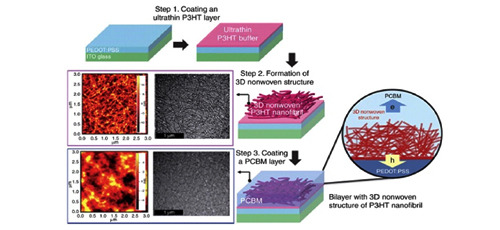
Citation of the article: Adv. Mater. Lett., 2020, 11(11), 20111571. [Download Full Text in PDF]
Article 3. Influence Of Different Copolymer Based Compatibilizers On Performance Of Pristine And Recycled PP/PE Blends
The third article of this issue is written by C. Rosales et al, where authors’ research is focused on the one of the big engineering challenges in recycling thermoplastics in terms of mechanical properties such as toughness or strength. Here author emphasize that the one of the strategies to improve PE/PP blends performance is to add a special compatibilizer, and this is the aim of the present work. Here, four different commercial masterbatch compatibilizers based on copolymers were added to pristine blends and microstructure and morphology were analyzed by DSC and SEM. Tensile and fracture studies were carried out at quasi-static loading conditions and fracture surfaces were studied by SEM. It was observed that results found for pristine blends were consistent with those of recycled blends, and the addition of compatibilizing masterbatches improved the performance of both pristine and recycled PP/PE blends.
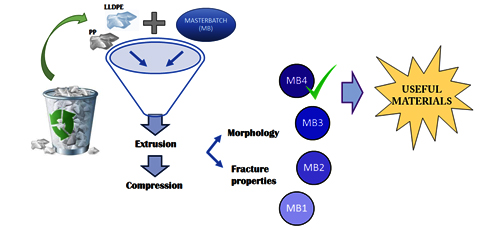
Citation of the article: Adv. Mater. Lett., 2020, 11(11), 20111572. [Download Full Text in PDF]
Article 4. Bio Ceramics: New Material From Mangrove Bark
The fourth article of the issue talks about the mangrove’s plants, which are salt-tolerant plants of tropical and subtropical intertidal regions of the world. The specific regions where these plants occur are termed as 'mangrove ecosystem'. An attempt was made here, to find out largest sources of plants, the mangroves, which are rich in several secondary metabolites. So, some mangrove barks are tested as a new source as a bio ceramic material by using bone marrow mesenchymal stem cells (BMMSCs). From the study it is revealed that among all tested barks, prop root bark of Rhizophora mucronata shows higher biocompatibility for cell adhesion. Thus, this study will enlighten the use of natural products to replaces chemical health hazards for ceramic material as ecofriendly materials.
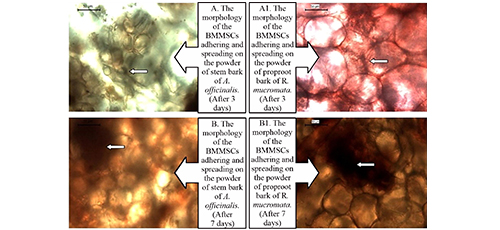
Citation of the article: Adv. Mater. Lett., 2020, 11(11), 20111573. [Download Full Text in PDF]
Article 5. Hybrid Physical Chemical Vapour Deposition (HPCVD) Of Superconducting MgB2 Thin Films On Three Dimensional Copper Substrates
The fifth article reports the design, development, and application of a novel Hybrid Physical Chemical Vapour Deposition (HPCVD) technique for depositing MgB2 thin films, with potential superconductivity, directly on three dimensional (3D) surfaces. A novel solenoid magnetron based set up was used for depositing MgB2 thin films on 3D surfaces of Cu tube. Mg rod was used as the sputter target and source of Mg while high purity BBr3 was used as a novel boron precursor, which was injected into the system using Argon as carrier gas. Here, samples were characterized by SEM, EDX, XRD and SQUID techniques. Superconductivity analysis carried out using SQUID measurements indicated a sharp transition with Tc value of 39 K. From the M-H hysteresis loop, the lower critical field Hc1 and critical current density Jc at 4.2 K were calculated to be 700 Oe and 3.5 x 107 A/cm2, respectively.
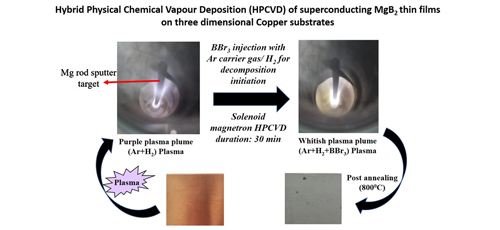
Citation of the article: Adv. Mater. Lett., 2020, 11(11), 20111574. [Download Full Text in PDF]
Article 6. Photoinduced Electron Transfer Reactions Of Tris(4,4’-Dimethoxy-2,2’-Bipyridyl) Ruthenium(II) Cation With Quinones In Aqueous Medium
The sixth article emphasize about the photoinduced electron transfer reactions of [Ru(dMeObpy)3]2+ complex with quinones, which have been studied in aqueous medium by luminescent quenching technique. The quenching rate constant kq is sensitive to the nature of the quencher and the electron transfer distance between the luminophore and the quencher, the reduction potential of the quinones. The nature of quenching is confirmed from ground state absorption studies. The oxidative nature of quenching is confirmed from the formation of Ru3+ ion and quinone anion radical. Results show that structural effects also influence the rate of electron transfer reaction.
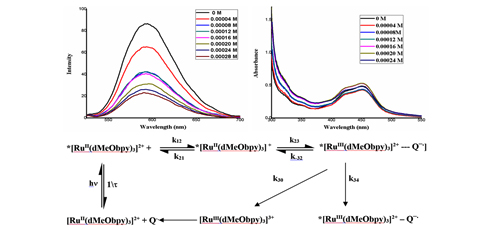
Citation of the article: Adv. Mater. Lett., 2020, 11(11), 20111575. [Download Full Text in PDF]
Article 7. A Comparative Study Of Green Synthesized AgNPs Using Carissa Carandas And Nerium Indicum Leaves And Its Activities Against Selected Human Pathogens And MCF 7 Cell
The seventh article of the issue presents the details about the ecofriendly method for biosynthesis of AgNPs using an aqueous leaf extracts of Carissa carandas and Nerium indicum plants. The obtained AgNPs were characterized by Ultraviolet–Visible Spectrophotometry. TEM analysis shown morphology and crystalline of nanoparticles as 20 and 40 nm sizes and spherical shape. Here authors studied the SEM, EDXA and FTIR analysis. The AgNPs showed high potential antibacterial activity toward the selected pathogenic bacteria. Therefore, Carissa carandas and Nerium indicum leaves aqueous extract AgNPs can provide application in future development as nanomedicine, nanotechnology as antifungal activity on Aspergillus niger and candida albicans and then anticancer activity on MCF-7 cell line. Finally, the Nerium indicum leaves aqueous extract AgNPs were more effective in antibacterial, antifungal and anticancer activity than Carissa carandas AgNPs.
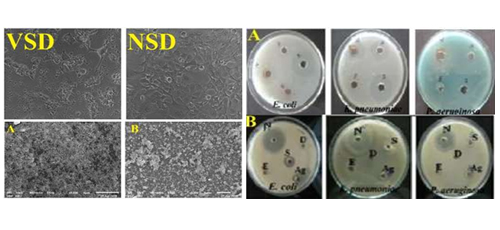
Citation of the article: Adv. Mater. Lett., 2020, 11(11), 20111576. [Download Full Text in PDF]
Article 8. Design And Modelling Of Carbon Fiber Grid Structure Based Carbon/Epoxy Composites For Enhanced Microwave Absorbing Properties
The eighth article of the issue is devoted to the approach for microwave absorbing properties by using carbon fiber grid layers. Frequency Tunable Microwave absorbers in desired low thickness is a critical requirement in electronics, radar, and military applications where Electro Magnetic Interference has become a major concern. Composites are obvious choice of absorbers in above applications. In this work, three key points are highlighted, first is design, modeling of FSS grid, second is the use of fillers including Milled Carbon Fibers and Carbon Nano Tubes (CNTs), third is to have the desired reflection loss at specified thickness of around 6-7 mm which is low as compared to recent trends. Here, results are satisfactory showing minimum of -9.8 Db of Reflection Loss at 6-7 mm thickness laminates, for varied range of frequency.
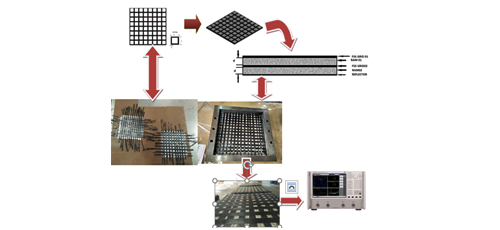
Citation of the article: Adv. Mater. Lett., 2020, 11(11), 20111577. [Download Full Text in PDF]
Article 9. Elaboration And Characterization Of Macroporous Bioceramics Using Polymeric Sponge Replication Method
The ninth article of the issue described that biomedical porous fluorapatite scaffolds were fabricated using an improved polymeric sponge replication method. Here, the specific formulations and distinct processing techniques, the multiple coatings with the desired viscosity of the Fap slurries were used. The results show that obtained porous Fap scaffolds had uniform porous structures with completely interconnected macropores of 850 μm. In addition, micropores of 4 μm were formed in the skeleton of the scaffold. Finally, the porous Fap scaffold with a porosity of 65 vol.% and a surface of 400 mm2 had a compressive strength of 7 MPa.
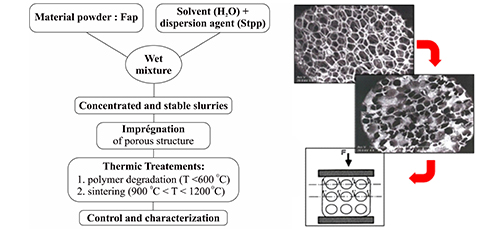
Citation of the article: Adv. Mater. Lett., 2020, 11(11), 20111578. [Download Full Text in PDF]
All above articles discussed the role of biomaterials and polymeric materials in the healthcare and energy, which further makes better understanding about advancement of the materials science for sustainable and healthy environment. These contributions have been made available in 'open access' format and readers can access online at https://www.vbripress.com/aml/. International Association of Advanced Materials, IAAM is engaged in the promotion of not-for-profit Diamond Open Access Policy. Here, IAAM invited research professional in materials science and technology to share their insights in the form of reviews, trends, or perspectives in the Advanced Materials Letters. The peer-review process of submitted articles in the Advanced Materials Letters is done by manuscript central, ScholarOne – Web of Science Group – Clarivate Analytics, USA.
Related Post: -
November 4th, 2020 IAAM Blog International Association of Advanced Materials Leave a Comment
Leave a Reply
Your email address will not be published. Required fields are marked *
Search
Recent Posts
- The 15th Anniversary of Advancing Materials
- Materials Triggered Towards Climate Neutral and Bio Active Functionality Via Nano and Electrochemical Interaction: Evolution of Advancement in the Volume 12 of Advanced Materials Letters, August 2021
- Promising Materials Features Transforming Sustainable Development with Intelligence and Green Chemistry: Exclusive Paradigm of the Volume 12 of Advanced Materials Letter, July 2021
- Attaining the SDGs Through Resilient Approach Needed High Performances Materials, Symbolize in the 6th Issue, Volume 12, June 2021 of Advanced Materials Letters
